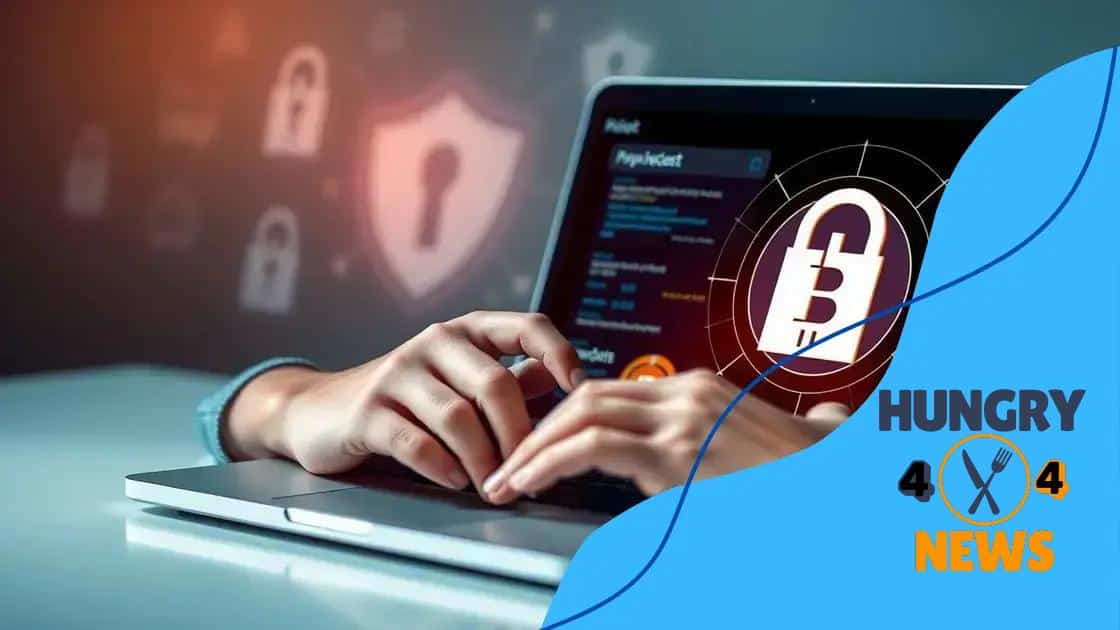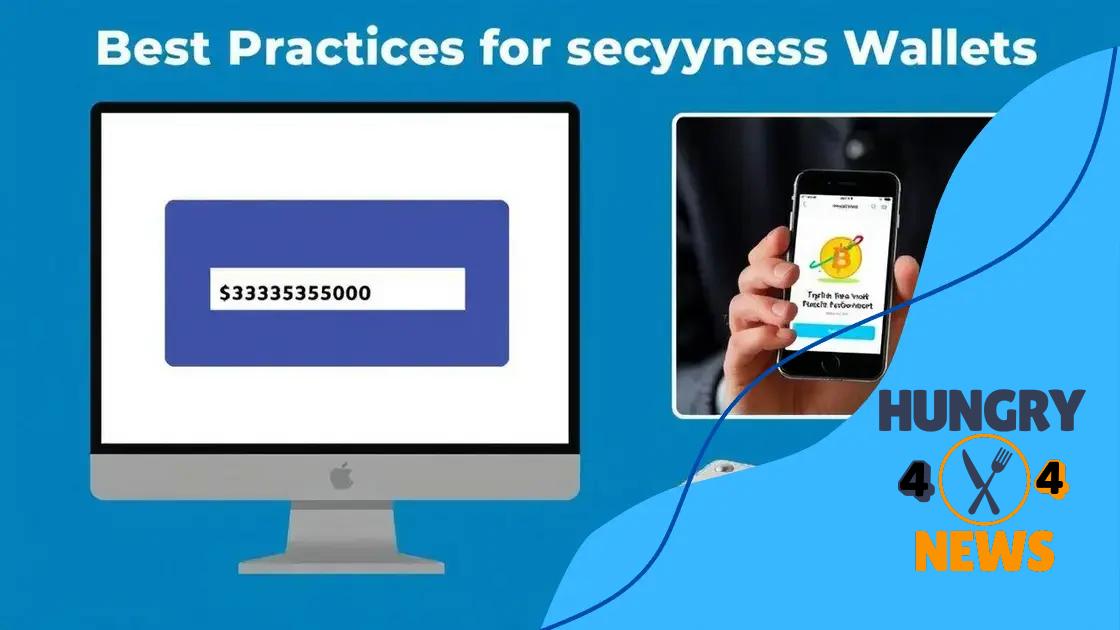Cryptocurrency wallet protection and security best practices

To secure your cryptocurrency wallet, use strong passwords, enable two-factor authentication, keep software updated, and choose reputable wallets to protect your digital assets effectively.
When it comes to managing your assets, cryptocurrency wallet protection and security best practices are paramount. Have you ever thought about how vulnerable your digital assets might be? In this article, we’ll discuss valuable tips to ensure your wallet remains secure.
Understanding different types of cryptocurrency wallets
Understanding the various types of cryptocurrency wallets is essential for anyone looking to secure their digital assets. Each type has its own unique features and security levels.
Hardware Wallets
Hardware wallets are physical devices that store your cryptocurrency offline. They are one of the most secure options available. Because they are not connected to the internet, they significantly reduce the risk of cyberattacks.
Software Wallets
These wallets come as applications on your computer or mobile device. Software wallets are convenient for everyday transactions and can be divided into hot and cold wallets. Hot wallets are connected to the internet, making them easier to access but more vulnerable. Cold wallets, however, are only connected temporarily, providing enhanced security.
- Hot wallets for quick access
- Cold wallets for enhanced protection
- Both can manage multiple cryptocurrencies
- Software wallets can be user-friendly
Many people also use web wallets, which are accessible through web browsers. These wallets offer convenience but come with a higher risk since your private keys are stored online, potentially making them accessible to hackers.
Paper Wallets
A paper wallet is a physical printout of your public and private keys. They are considered very secure if created correctly. However, they can be easily damaged or lost, hence necessitating careful handling. Always remember to generate a paper wallet in a secure environment.
Mobile wallets are another popular choice, especially among users who want to make transactions quickly. These apps facilitate easy access and spending of cryptocurrency right from your smartphone.
Understanding these types of wallets is key to securing your assets. Consider your personal needs and security preferences when choosing the right wallet.
Common threats to wallet security
When using cryptocurrency wallets, it’s vital to be aware of the common threats to wallet security. Understanding these threats can help you protect your digital assets effectively.
Phishing Attacks
Phishing attacks are one of the most prevalent threats. Cybercriminals often create fake websites or emails that look legitimate to trick users into revealing their private keys or passwords. Always verify the source before entering any sensitive information.
Malware
Malware can infect your devices and steal your cryptocurrency without your knowledge. It is crucial to have reliable antivirus software installed. Additionally, avoid downloading software from untrusted sources.
- Keep your device’s software up to date
- Use secure passwords and change them regularly
- Enable two-factor authentication
Another significant threat is man-in-the-middle attacks. In this scenario, attackers intercept the communication between you and the wallet service, potentially gaining access to your account. Ensuring you use secure connections and verified services helps mitigate this risk.
Additionally, lost or stolen devices can be catastrophic. If your phone or computer is taken, anyone can access your wallet if proper security measures are not in place. Always use strong passwords and lock your devices.
Staying informed about these threats is crucial. By taking proactive steps, you can significantly enhance your wallet’s security.
Best practices for securing your wallet

Securing your cryptocurrency wallet is important for protecting your digital assets. Following best practices can help you minimize risks and strengthen your wallet’s security.
Use Strong Passwords
One of the first steps in securing your wallet is to use a strong and unique password. Avoid common phrases and use a mix of letters, numbers, and symbols. Consider using a password manager to keep track of your passwords safely.
Enable Two-Factor Authentication (2FA)
Two-factor authentication adds an extra layer of security to your wallet. This feature requires not just your password but also a second form of verification, such as a code sent to your smartphone. Always enable 2FA on your wallets whenever possible.
- Choose wallets that offer 2FA
- Keep your authentication device secure
- Regularly update your authentication methods
Another essential practice is keeping your software up to date. Software updates often include security patches that protect against new threats. Regularly check for updates for your wallet app and the device it runs on. It’s important to stay vigilant against potential vulnerabilities.
Consider using a hardware wallet for added security. Hardware wallets store your crypto offline and are less susceptible to online attacks. These devices require you to confirm transactions, making them safer for storing large amounts of cryptocurrency.
Lastly, be cautious when connected to public Wi-Fi networks. Avoid accessing your wallet or making transactions on unsecured networks, as this could expose your sensitive information to hackers. Use a Virtual Private Network (VPN) if you need to access your wallet on a public Wi-Fi network.
How to choose a secure wallet
Choosing a secure cryptocurrency wallet is crucial for the safety of your digital assets. It’s important to consider various factors before making a decision.
Assess Your Needs
Begin by assessing your needs. Are you looking for a wallet for daily transactions, or will you be storing large amounts of cryptocurrency for the long term? Knowing what you need will help narrow your options.
Consider Security Features
Look for wallets that offer advanced security features like two-factor authentication and multi-signature options. These features add extra layers of protection to your wallet. Ensure that the wallet you choose encrypts your private keys and provides backup options as well.
- Two-factor authentication for added safety
- Multi-signature support for shared accounts
- Backup and recovery options for your wallet
Also, check the wallet’s reputation in the cryptocurrency community. Research user reviews and feedback. A wallet with a strong history of security and customer service is a good choice. You can find this information on forums and review sites.
Another important aspect is the wallet’s compatibility with various cryptocurrencies. Ensure that the wallet supports the specific coins you plan to store. Some wallets are designed only for specific cryptocurrencies, while others can handle multiple types.
Lastly, think about the potential for future needs. Will your chosen wallet accommodate future upgrades or additional features? Picking a wallet that can grow with your requirements is wise.
Steps to take if your wallet is compromised
If you suspect that your cryptocurrency wallet has been compromised, it is essential to act quickly to protect your assets. Here are the steps you should follow.
Immediately Disconnect from the Internet
The first thing to do is disconnect your device from the internet. This limits further access by potential attackers and helps to secure your sensitive information. Turn off your Wi-Fi and unplug any Ethernet connections.
Check for Unauthorized Transactions
Next, review your transaction history for any unauthorized transactions. If you notice any suspicious activity, make a note of these transactions. Take screenshots if possible, as this information may be helpful for future investigations.
- Log transactions with dates and amounts
- Check both incoming and outgoing transactions
- Contact your wallet’s support if needed
Once you have assessed the situation, it is time to change your passwords. Update your wallet password immediately. Ensure that your new password is strong and unique. Avoid using the same password across multiple platforms, as this can increase your vulnerability.
If your wallet provides two-factor authentication (2FA), enable it if you haven’t already. This step adds an extra layer of security by requiring a secondary code for access.
In some cases, you might need to transfer your remaining funds to a new wallet. Set up a new wallet using a secure and trusted service. Ensure that this new wallet follows all recommended security practices. Once established, transfer your assets without delay.
Finally, report the incident. Notify your wallet provider and any relevant authorities, especially if your funds are stolen. They may offer additional support and monitoring for your account.
FAQ – Frequently Asked Questions about Cryptocurrency Wallet Security
What should I do if I think my wallet is compromised?
Immediately disconnect from the internet, check for unauthorized transactions, change your passwords, and consider transferring your assets to a new wallet.
How can I secure my cryptocurrency wallet?
Use strong passwords, enable two-factor authentication, keep your wallet software updated, and choose reputable wallet providers.
What are the common threats to wallet security?
Common threats include phishing attacks, malware, man-in-the-middle attacks, and lost or stolen devices.
How do I choose a secure wallet?
Assess your needs, look for strong security features, check the wallet’s reputation, and ensure it supports the cryptocurrencies you want to store.





